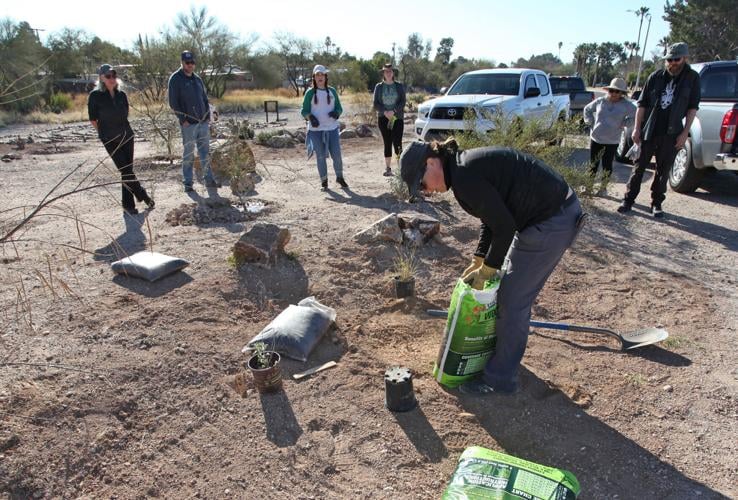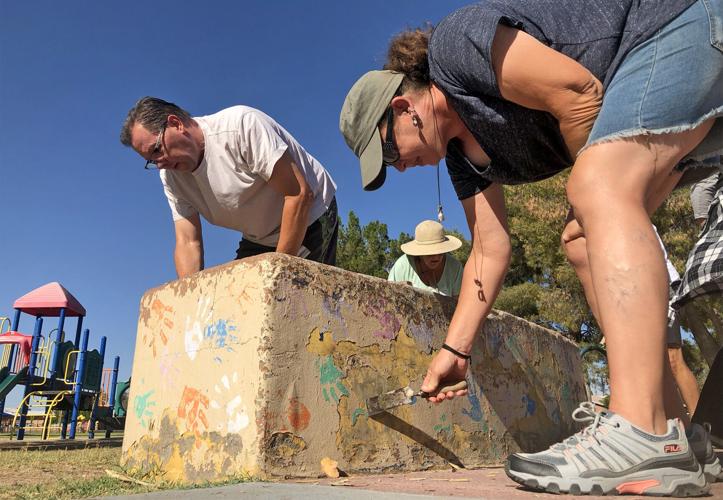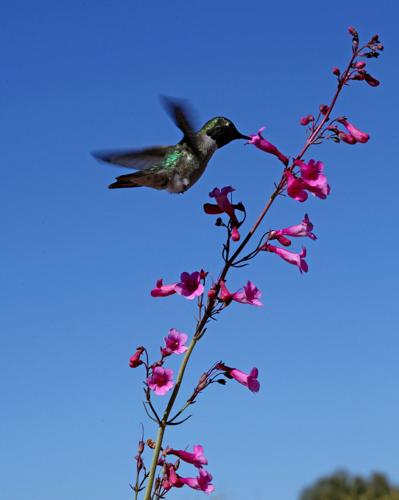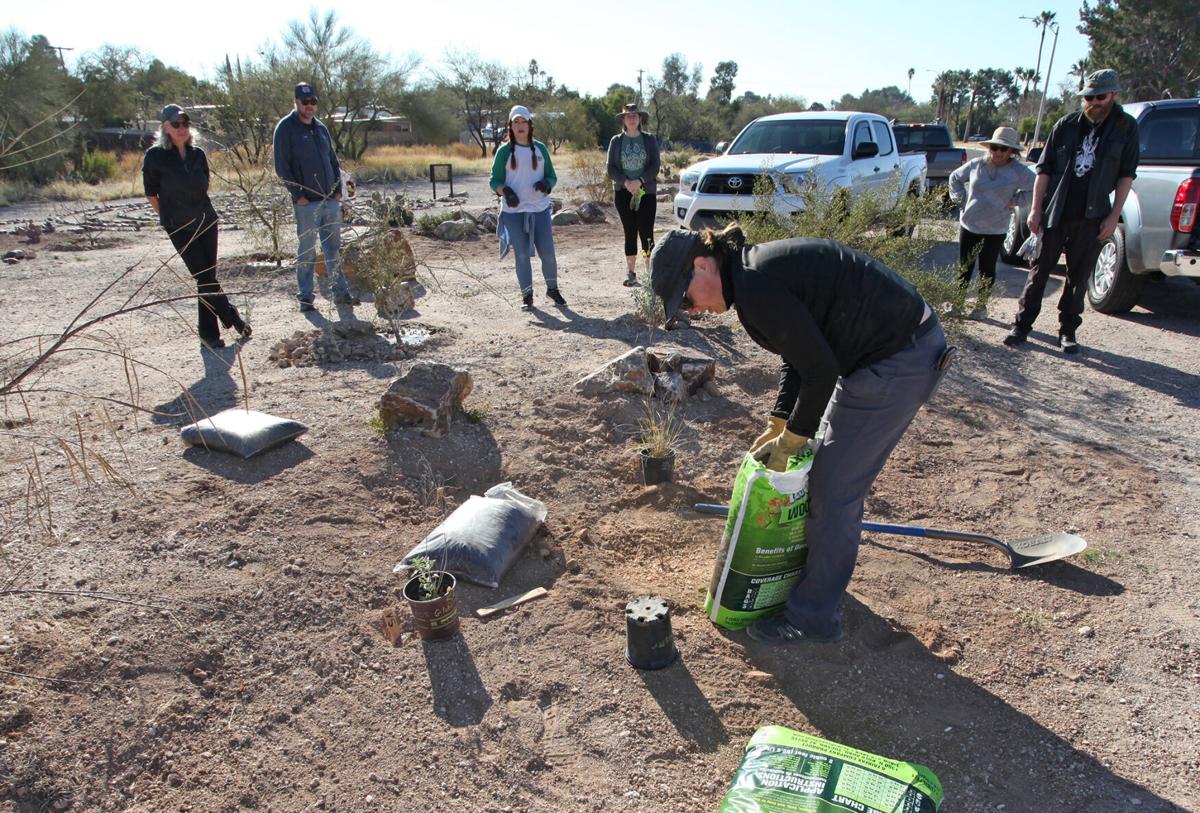A few dozen midtown residents gathered at a mostly empty lot on a recent Saturday morning, armed with shovels, soil and 58 plants known to attract butterflies, bees and other native pollinators.
The hardest work had already been done for them. The swath of land previously used as a dumping site had been prepared the week before, and the pollinator garden was already mapped out by experts. So for these residents of the Palo Verde Park neighborhood, the planting party was all about fun.
They dug holes and chatted as the flora and fauna-themed songs of performer Mr. Nature (Tucsonan Anthony Aldinger) wafted through the gentle morning breeze. Mr. Nature was on hand to record his weekly podcast, singing songs that included "Pollinators Rock" and "I Love Bees."
"A year ago I told my son this won't be done in my lifetime," one neighbor said to another. "Look at us today!"
A little over an hour later the planting was done, and neighbors high-fived and cheered their success. A plan was set to divvy up watering duties until a more permanent solution is in place, and with that, the latest improvement effort spearheaded by the Palo Verde Park Neighborhood Association was complete.

The association is one of 145 volunteer-based groups around the city that are quietly doing important work to help their residents, ranging from beautification of common spaces, to outreach events to connect residents with services, to social gatherings to help build community.
With 145 neighborhoods in Tucson, there's more work to be done than city departments can handle quickly and efficiently when faced with government processes, limited funding and staffing shortages. But the board members of Palo Verde Park and Tucson's other neighborhood groups are happy to do it, recognizing that everyone needs to pitch in to create the best possible community.
Uniting neighborhood voices
The Palo Verde Park Neighborhood Association was started in the spring of 2018 by a group of neighbors hoping to build a stronger community through collaboration, connection and civic engagement. The neighborhood spans the area from East Broadway to East 22nd Street, and from Kolb Road to Wilmot Road, and is comprised of six subdivisions.
"There was a group of us that was pretty active on the app on Nextdoor, just kind of looking out for the park and taking care of the park and the neighborhood as a whole," said association president Mike Southworth. "We were kind of surprised there was no neighborhood association in the area, because the homes were built in the 1950s."
News archives showed the neighborhood had been active over the years, but residents had never formally organized, Southworth said. So he and others decided to make it official.
"From the very beginning our thoughts were to be service-minded but also bring in folks from around the city and other resources that might be of interest to our neighbors," Southworth said. "It's given us a really united voice and helped us to become a partner with parks and with Ward 2."
The group has undertaken several projects, ranging from simple to complex, and always with the approval of — and often assistance from — city officials. The past few years, the work has grown.
One of the group's first projects was a poolside mural created in summer 2019 by students from Palo Verde High School, who were chosen by the Arts Foundation for Tucson and Southern Arizona in partnership with the Pima Association of Governments. The mural, which focuses on the history and culture of the neighborhood, was designed and painted by students and led by local artist Isaac Caruso.
In January 2020, the park received a large Tucson Clean and Beautiful grant for a water harvesting project along the park's perimeter and beautification of a parcel of land to the east of the park. Neighbors did the work to clear the area and plant the trees.

Residents of the Palo Verde Park Neighborhood Association scrape years of paint off a concrete wall to prepare it for painting.
When the pandemic came to town, some plans had to change, but the neighbors didn't stop working. They couldn't hold their planned spring events, so residents instead turned their attention to cleaning up goatheads, trash and weeds from the park, making it friendlier for bare feet, dog paws and picnic blankets.
By summer, they'd put up a new bulletin board, designed by Iron Horse Fabricators, which also brought in a "Locks of Love" sculpture, similar to those that line North Fourth Avenue. Hoping to provide young visitors with a bit of enchantment, the board also adorned the trees surrounding the playground with hanging artwork depicting faces and characters.
In September, a group of neighbors assembled a "Peace Labyrinth" out of three tons of rocks at the east annex of the park, near where the pollinator garden now resides.
For Veterans Day, the association celebrated the Naval Reserve Construction Battalion which built the bridge in 1959 to help students from the east part of the neighborhood cross the Arroyo Chico Wash to get to school. Neighbors painted the bridge a brilliant blue and installed a commemorative plaque with details about the bridge's origin.
And as the pandemic raged on in 2021, the neighbors kept grinding. They held outdoor events, painted park benches and that summer, raised $1,000 in less than a week to resurface and paint a short cement wall at the playground. By the time the holidays rolled around, the playground welcomed visitors with its impossible-to-miss wall adorned with sunflowers and wildflowers.
Fundraising for the same neighborhood artist, Angela Pittenger, to paint a retaining wall at the opposite end of the park has just been completed.
"The park is the centerpiece and that's been a lot of our focus, to make sure that there's been some investment and that we're partnering with the city and other agencies to try to make a difference here," said board secretary Rhonda Bodfield. "We want people to know the history of this area, because it's really interesting. This was part of the big boom on the east side."
The Palo Verde Park neighborhood was on the outskirts of town when it was built in the 1950s. The area catered to veterans.

A hummingbird approaches a Parry’s penstemon at Palo Verde Park just minutes after a group of friends and neighbors in the Palo Verde Park neighborhood planted a pollinator garden on Feb. 26.
The pollinator garden marks the first project of 2022. With fundraising beginning on Jan. 8, the board quickly raised more than the $570 it needed to buy plants before the Jan. 30 deadline.
"What's great about this park is that a lot of people from outside the neighborhood come because of all the ball fields and the games. It's nice to see that other people like the park and they come and enjoy it and feel safe here. That's a big deal for us," said treasurer Andy Weiss. "I love that I can see the lights from my house and hear the kids at night, and it's just great to have the background noise of little football players and baseball players, and to hear their excitement."
Creating safe places
Over in the west side's Barrio Hollywood, similar work is being done, but this neighborhood association has been active since 1989.
Vice President Scott Egan, one of the founding members, said the group is a little more controversial than some of the other associations in town, having gone head-to-head with the city over the years on a number of issues, including a proposed sale of El Rio Golf Course to developers for a private college campus to be built on site.

Bella Pendolino (cq) and her father Steve Whetherhult (cq) slowly remove a flower from its container before planting it at Palo Verde Park in Tucson, Ariz., on Saturday, February 26, 2021. A group of friends and neighbors in the Palo Verde Park Neighborhood raised funds to plant a pollinator garden on a parcel of land near their park on the city’s eastside.
"Some people in the city don't love us as much as others," Egan said. "But we're there to support the neighborhood."
For more than a decade, the Barrio Hollywood Neighborhood Association hosted its annual Fiesta Grande celebration along North Grande Avenue, with thousands of people coming out for the open air event each year. The event stoped a few years ago when the group ran out of money, but Egan says people are constantly asking for it to return.
The association also applied for and received a $1 million grant from the state's transportation fund to rebuild Grande Avenue in the late-aughts, installing new sidewalks, repaving the streets and putting in electrical outlets and water fountains. All the improvements were done in consultation with local businesses, and Egan says the association takes its role of supporting local businesses seriously.
For the past few years, the association has hosted an annual art show at El Rio Neighborhood Center and more recently, monthly open mic nights at the golf course. The open mic nights, which typically draw 40 to 50 people, are the effort of board member Ray Armstrong, who says the events are designed to help the golf course generate revenue.
"To me, it really means something," Armstrong said. "I play golf there and it's affordable. It's not for rich people."
The open mic nights have been taking place outdoors while the golf course's clubhouse is being renovated, with residents bringing their own food and the golf course offering drinks available to purchase. When it was cold, the staff of nearby Mariscos Chihuahua restaurant brought over space heaters, with generators powering the lights and the sound system.
"It's been fantastic," Armstrong said. "It's people that play in their living rooms and we'd never be able to see them unless they come to open mic. We get some people who do this stuff for a living, too."

Tucson has 145 active, volunteer-based neighborhood associations.
Those include guitarist and member of the Pascua Yaqui tribe Gabriel Ayala, as well as musician Bobby Ronstadt, who have been known to come down and play on more than one occasion.
"We've got really good outreach, and it's a safe place," Armstrong said. "That's the whole point: To create a safe place that's not politicized."
Before the pandemic, the association organized mayoral and city council candidate forums at El Rio Neighborhood Center. Armstrong says he hopes it can get back to those, as neighbors were very involved.
The city, county and Tucson Police Department all send representatives to the association's monthly meetings to provide updates to residents and listen to their concerns. Egan says he wishes the city would provide a little more support, because he remembers when there was a whole department dedicated to Tucson's neighborhood associations. But he's grateful for their attendance and attention.
"We're very protective of the neighborhood center and golf course, due to shenanigans the city has done in the past, so when we hear about things like that, they know we're going to raise hell," Egan said. "I am very in favor of preserving the culture and people in this area of town."
Building blocks of city government
A few blocks away from Barrio Hollywood, Menlo Park Neighborhood Association president Zach Yentzer says city staff has told him the neighborhood association is one of the largest and most active in the city. Menlo Park's association has been around since 1994.
"From almost the beginning, our ask to the ward office was to meet for 30 minutes once a month. Our vision was not to be a squeaky wheel, but how can we help them and bring more people to the table," said Yentzer, who has been president since 2018. "The ward office has said this has been helpful and they wouldn't otherwise hear when things are happening. They'd only hear about it when everyone's upset."

Ariel Gilbert-Knight (cq) loosens the soil inside a container holding a Parry’s penstamon as Thomas Bengford (cq) watches at Palo Verde Park in Tucson, Ariz., on Saturday, February 26, 2021. A group of friends and neighbors in the Palo Verde Park Neighborhood raised funds to plant a pollinator garden on a parcel of land near their park on the city’s eastside.
Menlo Park residents are in the process of creating an official neighborhood plan, which would recommend how land in the area is to be used and looks ahead to the next 50 years of the community. The plan has been commissioned by the city and will need to be approved by the mayor and city council upon its completion. The plan, once adopted, would become an official document that recommends land use in the area and that city leaders would reference when deciding if a development or project can come to Menlo Park.
With rapid redevelopment taking place in Menlo Park and downtown over the past five years, Yentzer says the group thought it was time for the city to have some official guidance to refer to going forward.
"This is the most comprehensive outreach process the neighborhood has ever gone through," Yentzer said. "Thousands of people live in this neighborhood and we get to be this conduit that shares with the city that 'this is what we want'."
During COVID-19, when meetings moved to virtual, the association launched its Vecinos — the Spanish word for neighbors — initiative, creating block ambassadors to gather input from neighbors and get the word on what was happening in Menlo Park. It just received some grant funding to expand the initiative, which Yentzer says will be very effective in keeping people informed and connected.
"This will mean more door-knocking and more interface with neighbors," he said.
The group has organized cleanups, vaccine clinics and other services in the park. Its members also fought for and won millions of dollars in infrastructure improvements promised by the city for decades to a small neighborhood within Menlo Park. Now, residents of Barrio Sin Nombre enjoy new lights, paved roads and an official marker with the neighborhood's name.
"Neighborhood associations are the building blocks of city government," Yentzer said. "I always encourage young people to get involved with their neighborhood associations. These are tangible places where good things get done. They're connecting people together, but also also giving them a voice on some different issues."
The residents of the Palo Verde Park Neighborhood Association raised funds to plant a pollinator garden in an area previously used as dumping site, then invited residents out for a planting party. Video by Caitlin Schmidt / Arizona Daily Star.
Hard work paying off
With city resources tight and staffing limited within the parks and other departments, there's a lot of demand for improvements and services, which is part of the reason groups like the Palo Verde Park association are trying to help out.
City Parks Maintenance Coordinator Hector Leyva has worked closely with the Palo Verde neighborhood association, saying its efforts helped alleviate some of the parks department's workload.
"They're the eyes and ears of the park when we're not there," Leyva said. "It's a back-and-forth thing. We greatly appreciate them, and my staff is right on top of it with what they need."
Efforts like these go a long way to help beautify parks and make them more inviting for children and families, which is what the department is seeking.
"With these parks being the way they are and so well-maintained, it's helping the community come out and want to come out," Leyva said. "That was the only bright spot of COVID, was that it brought everyone out to the parks."
Palo Verde's association doesn't have an operating budget, so all the improvements have been fundraised and completed with volunteer labor. The group always has at least a few projects in the works, both short-term and ongoing, and regularly communicates with city departments so there are no surprises.
"This is a working class neighborhood, so we're doing what we can realistically," said board secretary Bodfield. "But it would be nice to get some more grant funding."
As many of the projects involve greenery and there's no irrigation system in place, residents have had to get creative to keep the plants alive.
So once a week, usually Sunday mornings, board members and a few other dedicated volunteers take turns filling 20 five-gallon buckets with water from the spigot by the pool and watering each tree along the perimeter of the park. In the summer, this means 5 a.m. wake-up times. By April, the pollinator garden flowers will likely be on the same schedule, but it's a cause near and dear to their hearts.
"On any given weekend, there are folks out here pulling weeds and picking up trash and I think that people are seeing what we're organizing and building off of that," said association president Southworth. "And that's what we're trying to do at the end of the day, is make this a better place to live. And I think that's spreading. We're new, but we're already seeing our efforts pay off."











